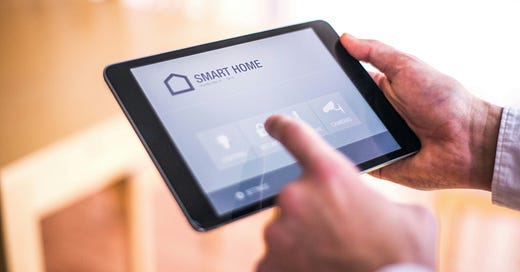Turn Your Home into an Energy-Saving Genius: The Smart Revolution
Billions of dollars per year are wasted on lights that people simply forgot to turn off.
Imagine your home anticipating your needs and effortlessly optimizing your energy use in ways that would be tedious to do manually–cutting off power-hungry devices automatically, adjusting temperatures for maximum efficiency, and giving you detailed insights into energy flows. This isn't science fiction; it's the reality of smart home automation.
With the right approach, you can save money and energy, but not all automation investments deliver equal returns. Let’s analyze the cost-benefit ratios of automatic control, communication, and measurement technologies across different climate zones to identify the most effective options for your home.
Easy: Quick Steps for Smart Savings
Add motion sensors in spaces like garages, basements, and outdoor areas where a forgotten light might stay on for days or weeks at a time. This is one of the most cost-effective automation upgrades available.
Install smart power strips for entertainment centers and home offices. These simple devices eliminate "vampire" power draws (such as a TV that continually uses power on standby mode) and can add a layer of protection against power surges and spikes. Borrow a “Kill A Watt” or another brand of smart plug to measure an appliance's power draw and confirm that your smart power strip is stopping all energy flow.
Find out how to use your utility's app or website to identify patterns in your energy use. This free step helps you verify savings and find additional opportunities for automation.
Intermediate: Smart Climate Control
Install a smart thermostat with learning capabilities, especially if you live in a cold or hot climate. The higher your heating or cooling bills, the more valuable the savings from a smart thermostat.
Add door and window sensors that integrate with your thermostat. As part of a home automation system, sensors can trigger an alert or prevent your HVAC system from running unnecessarily when windows are open, enhancing a smart thermostat's savings by up to 30%.
Set up automated temperature schedules based on your utility's time-of-use rates. This strategy can reduce HVAC costs by shifting energy use to lower-cost periods. Using cheap power can also help your local utility make the best use of its resources, bolstering grid reliability and lowering energy prices for everyone.
Advanced: Whole-Home Integration
Install a whole-home energy monitoring system with circuit-level tracking. While these systems cost hundreds of dollars, they may reveal enough ways to save energy to pay for themselves. For example, a spike in energy use may help you quickly catch situations like a bad seal on a refrigerator door that allows cold air to seep out, which otherwise might escape notice for weeks or months.
Integrate smart water heater controls, particularly in homes with electric water heating. These controls can reduce water heating costs by optimizing heating cycles. Most installations include a controller, sensors attached to the hot and cold water pipes, and an app you can use with the controller.
Implement automated ventilation controls that work with your HVAC system, but only in climates with frequent free cooling opportunities. The best systems monitor indoor and outdoor temperature and relative humidity and then control whether to use fans or air conditioning to reach the desired indoor conditions.
Expert: Custom Optimization
Use an open source platform like Home Assistant to create custom automation scripts that integrate multiple systems. Focus on coordinating proven technologies rather than adding expensive new ones.
Investigate demand response programs through your utility. Incentives may be available to help pay for equipment or compensate participants for participating in demand-side management programs that allow remote control of systems like water heaters or home batteries.
Consider automated blinds only in specific situations (large windows, extreme climates), as their return on investment is marginal in most applications.
Technical Note: Understanding Home Automation for Energy Savings
Home automation for energy savings encompasses any technology that automatically controls or optimizes energy-using systems. The key elements are:
Programming (rules or algorithms that determine how systems operate)
Sensing (detecting conditions like temperature, occupancy, or power draw)
Controlling (ability to turn devices on/off or adjust their operation)
Monitoring (tracking and reporting energy use and savings)
When evaluating automation technologies, consider:
Installation requirements (DIY vs. professional)
Integration with existing systems
Reliability and maintenance needs
Cost-benefit ratio
Usefulness in your specific home type and climate
The ENERGY STAR Smart Home Energy Management System program website is a good resource for learning more about home automation technology and finding certified smart thermostats, lighting and plug controls, appliances, electric vehicle chargers, and security devices.
Conclusion
Whether you start with a single smart power strip or build a comprehensive home automation system, you can use clever tools and techniques to speed you along on your journey to sustainability. Today’s technology makes increasing efficiency, comfort, and convenience easier than ever. You can join the growing community of people who are wisely choosing automation solutions that fit their needs and budgets, creating a more sustainable future—one smart step at a time.
References and Further Reading
Brits waste £4.4 billion a year by leaving lights on at home, abm:electrical
Installing a Remote Motion Detector for Lighting, Family Handyman
Are Smart Power Strips Worth It?, Constellation Energy Resources
How to Use the Kill a Watt Meter, Rideau Environmental Action League
How to Install your Aquanta Smart Water Heater Timer, Aquanta
Smart Home Ventilation Systems: A Comprehensive Guide, AireTech
Awaken your home, Home Assistant
Smart Home Energy Management Systems, ENERGY STAR





Sometime it might be interesting in exploring the different types of occupancy sensors. Some don't turn the lights on if you manually pushed the off button as you leave the space, others do, etc.
You also might mention that occupancy sensors also turn off ventilation fans which use electricity and exhaust condition air.